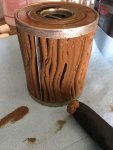rtadams89
Member
- 209
- 3
- 18
- Location
- Phoenix, AZ
I got my M35A2 recently with 9,000 miles on it. I put a coolant filter on (in a bypass setup) at about 9,500 miles. Just now at 10,000 miles I pulled the filter and cut it open to see how much had been caught. I was surprised to see the whole filter clogged with what I can only describe as mud. My initial reaction was quite the freak out, as the sheer volume and consistency looked like someone dumper a bunch of dirt into the cooling system. After thinking about it, I'm wondering if it isn't stop-leak though? I know the previous owner replaced the radiator shortly before I bought the truck. My thought is that the old one was leaking, someone dumped in (a lot) of stop leak and never flushed the system when the radiator was replaced. Does what you see in the picture look like stop-leak, or do you think it is something else/indicative of a real problem? If it is stop-leak, I'm assuming most of it has been caught by this filter; should I flush the whole system or just replace the filter and expect it to clog up more quickly before all of the stop-leak gets caught?




